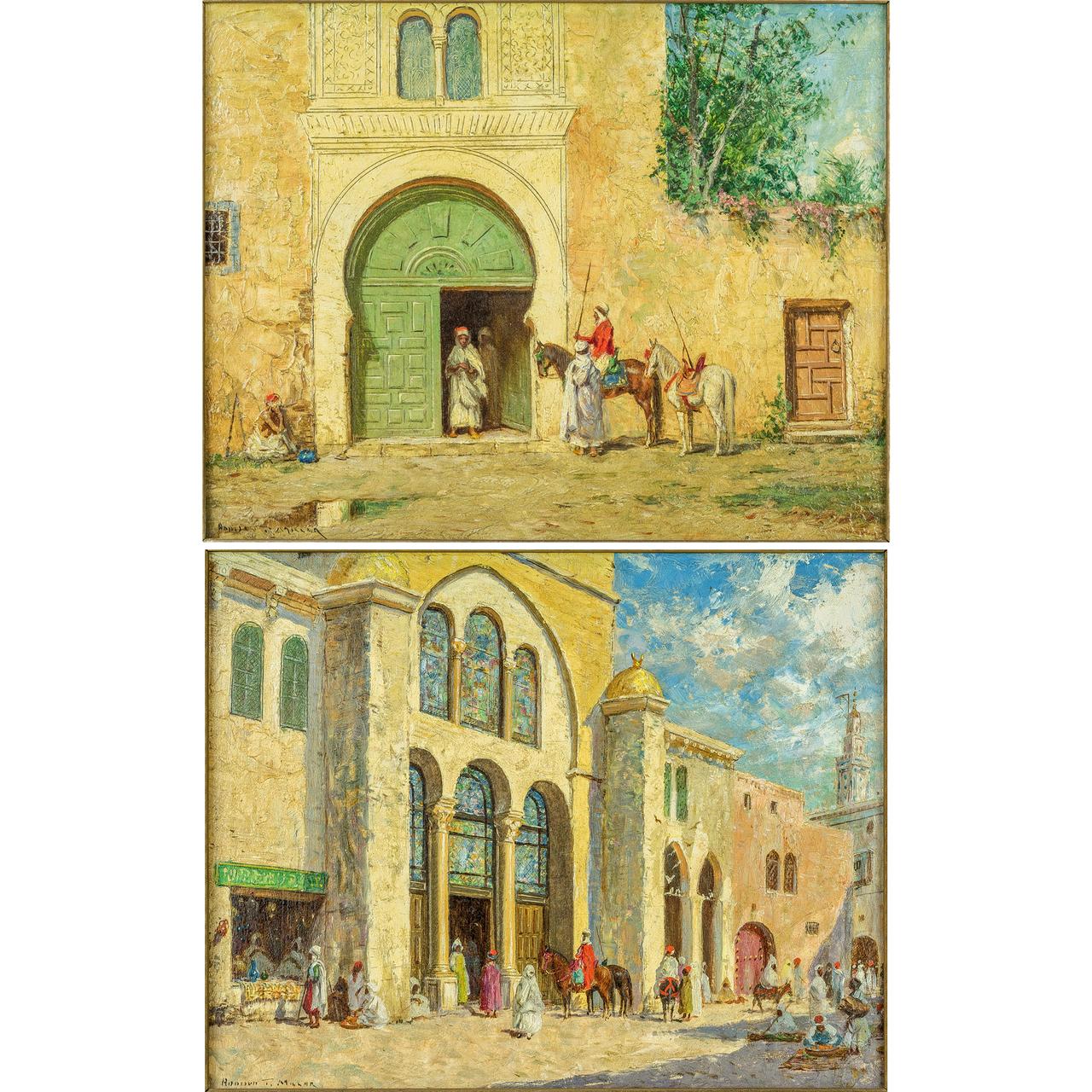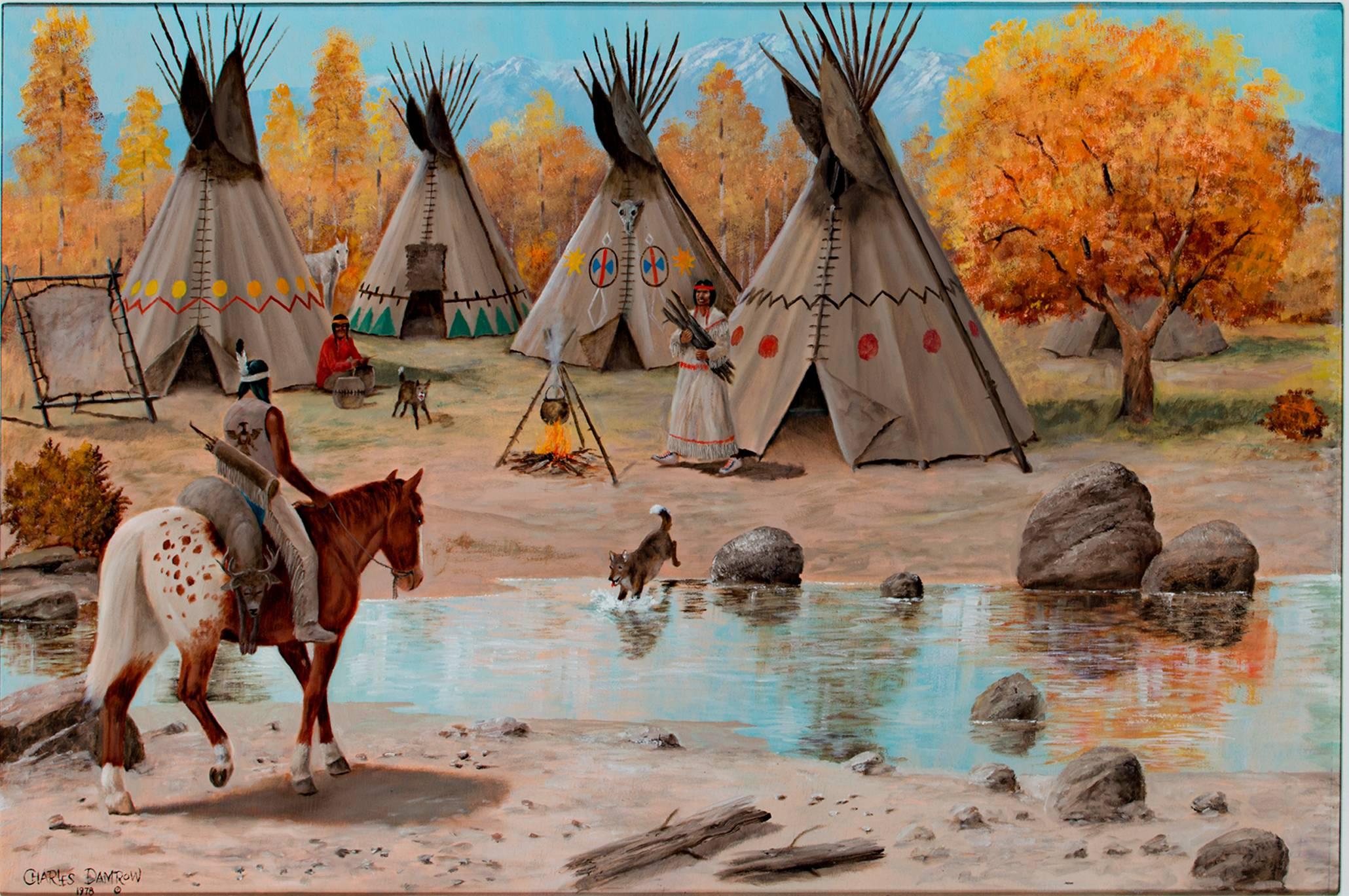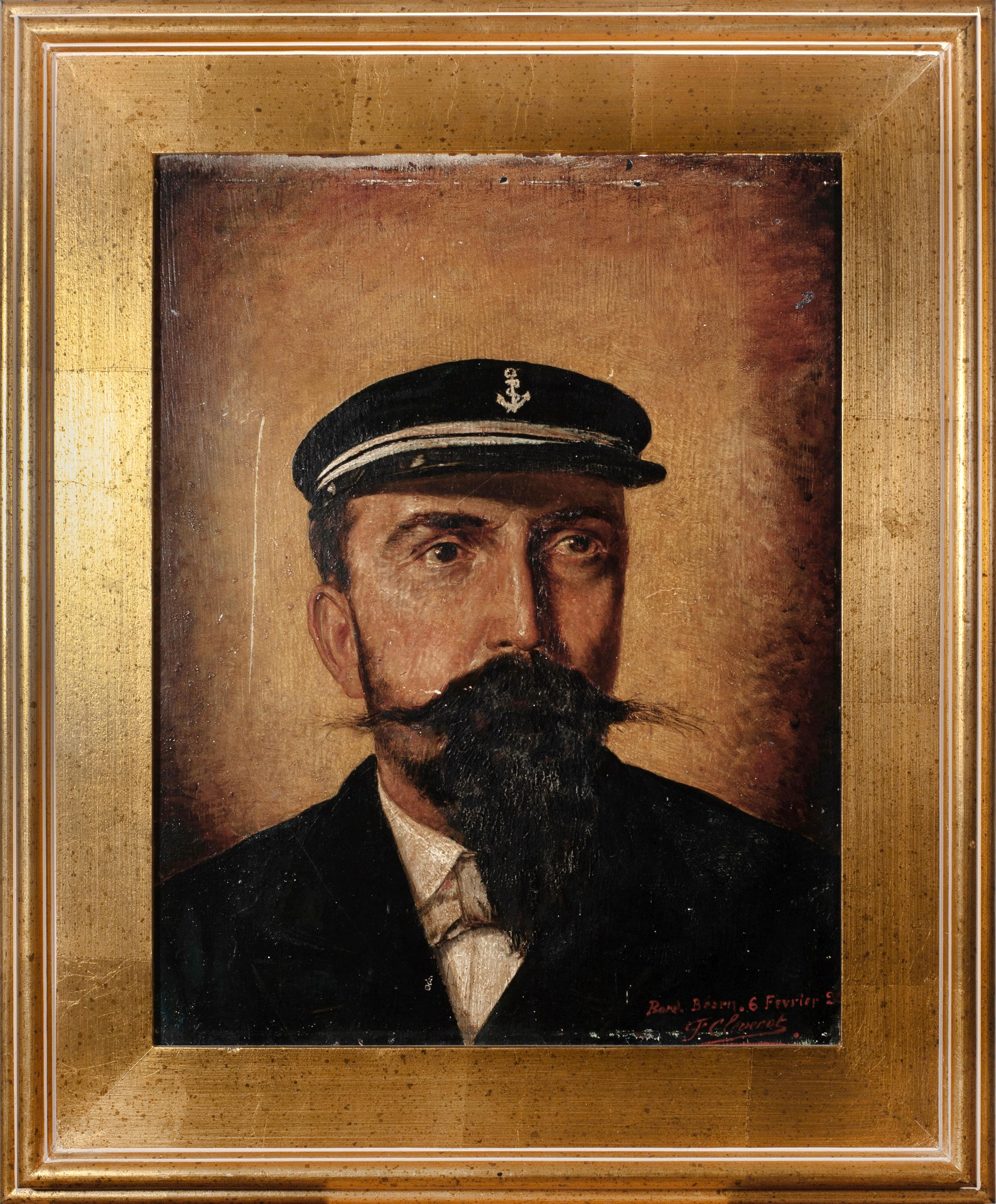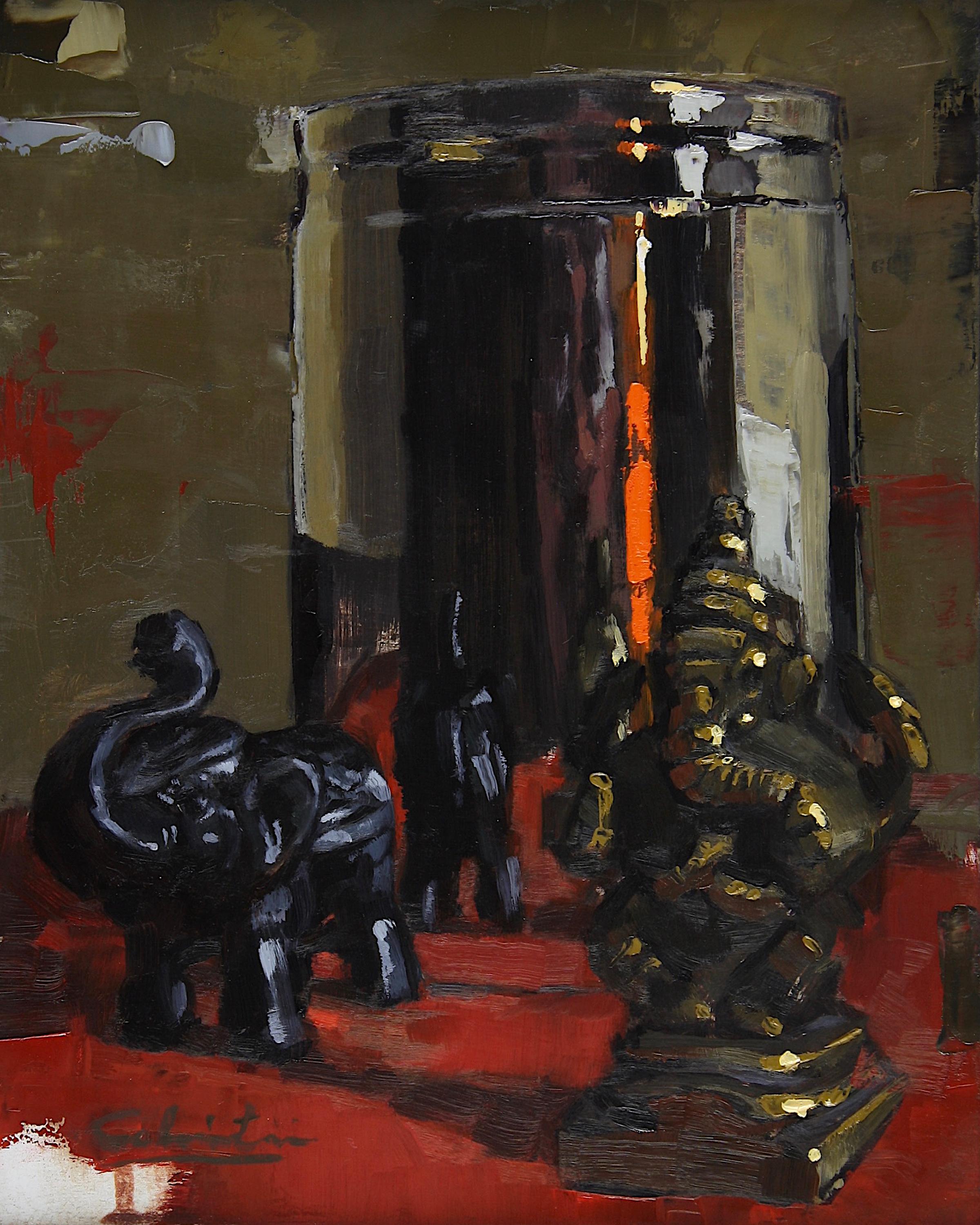Items Similar to The Tax Collectors attributed to Marinus van Reymerswaele
Want more images or videos?
Request additional images or videos from the seller
1 of 9
The Tax Collectors attributed to Marinus van ReymerswaeleCirca 1540
Circa 1540
About the Item
Marinus van Reymerswaele
c.1490 – c.1546 Dutch
The Tax Collectors
16th century
Oil on wood panel
Marinus van Reymerswaele stands among the greatest and most beloved artists of 16th-century Antwerp. Entitled The Tax Collectors, this oil on board original exudes the technical skill and life-like vibrancy for which the artist is renowned.
In a quiet interior scene, two men sit at a green table covered in coins, jewels, and empty moneybags. While the man in the red turban-like head wrap calmly records transactions in his leger, his companion grimaces, still clutching an empty coin purse. A meticulous painter, Marinus takes care to painstakingly render each minute detail with tremendous accuracy. Marinus has precisely lined each fold in their garments and each wrinkle on the men’s faces and hands. He further demonstrates his skill by capturing the reflections of light within the reflective gemstones and brass candlestick. His treatment of the men’s faces is caricatured but still believable, setting up an excellent satire on the tax collectors. Overall, the artist has imbued the scene with a lifelike vibrancy with a bold palette and confident application of paint. For further explanation of the incredible details in this work of art, please see the pictorial key.
The economic and cultural boom of 16th-century Antwerp effectively made the once-small Flemish city the financial center of the world. The greatest artists from all over the continent were drawn to the prosperity and sophistication of Antwerp. Without a doubt, a scene of two misers would have been immediately recognizable to a 16th-century European. The subject was one of the most popular of its time, gracing the collections of queens, kings and private citizens alike. All would have understood the image as satirical, poking fun at the two tax collectors wearing gaudy, outdated clothing with contorted faces. During this period, the citizens of Antwerp would have paid their taxes directly to the Habsburg dynasty of the Holy Roman Empire, centered in Vienna, leading to discontent among those in Flanders. The sudden advent of capitalism and urbanism stirred uncertainty among many about the world’s future. Despite these political and economic grievances, viewers could share a laugh at Marinus’s painting depicting the two men who served this oft-despised role.
Marinus van Reymerswaele, Dutch by birth, spent the majority of his life living and working in Antwerp. In 1509, he registered with the Antwerp Guild of St. Luke, cementing his position within the artistic fabric of the city by producing copies of beloved artworks. Nearly 500 years later, Marinus’s works reside in museums worldwide, including the Louvre in Paris, National Gallery in Washington D.C., and the Museo del Prado in Madrid. One version resides in Windsor Castle, within the King’s private quarters, and the Royal Liechtenstein collection acquired its own in 2008. It, like ours, displays the same remarkable color and expressive faces that characterize our masterpiece. Of these comparable paintings, only the Royal Liechtenstein example is equal to ours in quality and condition.
Circa 1540
Panel: 42" high x 31 3/4" wideFrame: 48 1/2" high x 38 5/8" wide x 3 3/4" deep
Provenance:
Acquired by Private Collection, United Kingdom circa 1880;
Thence by direct descent.
M.S. Rau, New Orleans
- Attributed to:Marinus van Reymerswaele (1490 - 1546, Dutch)
- Creation Year:Circa 1540
- Dimensions:Height: 48.5 in (123.19 cm)Width: 38.63 in (98.13 cm)Depth: 3.75 in (9.53 cm)
- Medium:
- Period:
- Condition:
- Gallery Location:New Orleans, LA
- Reference Number:
About the Seller
5.0
Vetted Seller
These experienced sellers undergo a comprehensive evaluation by our team of in-house experts.
Established in 1912
1stDibs seller since 2013
15 sales on 1stDibs
Typical response time: 5 hours
- ShippingRetrieving quote...Ships From: New Orleans, LA
- Return PolicyThis item cannot be returned.
More From This SellerView All
- Virgin and Child with the Infant Saint JohnBy Domenico PuligoLocated in New Orleans, LAA masterful example of Italian Mannerist painting, this exceptional panel was composed by the renowned Florentine painter Domenico Puligo. Alongside Jacopo Pontormo and Rosso Fiorentino, Puligo is remembered as one of the foremost figures of the Mannerist movement that rose to prominence during the 16th century in Florence. This panel of the Virgin Mary with the Christ child and Saint John the Baptist is a characteristic example of his celebrated devotional images, which grace museums such as the Metropolitan Museum of Art (New York), Museo del Prado (Madrid), Palazzo Borghese (Rome), and Palazzo Pitti (Florence), among many others. Puligo’s skill with color is fully demonstrated in the beautifully preserved work. Considering its age, the vibrancy and the sheer range of color is remarkable. The Virgin Mary’s crimson dress...Category
16th Century Mannerist Portrait Paintings
MaterialsOil, Panel
- The Connoisseur By Georges CroegaertBy Georges CroegaertLocated in New Orleans, LAGeorges Croegaert 1848-1923 Belgian The Connoisseur Signed "Georges Croegaert Paris" (lower right) Oil on panel A Cardinal peers through a magnifying glass at gilded treasures in...Category
19th Century Academic Figurative Paintings
MaterialsOil, Panel
- L’embarquement by Gaston La ToucheBy Gaston La ToucheLocated in New Orleans, LAGaston La Touche 1854 - 1913 French L’embarquement The Embarkment Signed "Gaston La Touche" (lower right) Oil on panel A fashionable group of merrymakers boards a rowboat at sundown in this oil on panel by renowned French painter Gaston La Touche. Softly lit and lushly detailed, the work represents the artist’s talent for capturing the gaiety of the Belle Époque. With its luminous coloring and feathery brushwork, this oil evokes the style and joie de vivre of the era rendered in La Touche’s distinctive, mature style. Fresh and airy, the work is a beautiful example of the artist’s skill at capturing the subtle qualities of light and color. Set against the plein air backdrop of a wooded pond awash in the soft glow of the golden hour, the scene reflects the influence of the Impressionists. The subject also recalls works by Manet, Monet and Renoir, who delighted in depictions of modern leisure among the expanding middle class. The scene is an informal one, and its unconventional cropping suggests that the viewer is invited to take a seat in the boat and join the group on their outing. Such relaxed, inviting scenes were remarkably popular among contemporary, modern audiences. However, La Touche's style is singular, possessing an element of fantasy and romance that set him apart from the Impressionists. Gaston La Touche was born in St. Cloud, outside of Paris, in 1854, and he showed a keen interest in art from a young age. At ten years old, he began taking private art instruction, which lasted until 1870, when his family was forced to flee to Normandy amid the Franco-Prussian War. This was the only formal art training La Touche would ever receive. Despite his lack of Academy training, he made his debut at the Paris Salon of 1875 with a sculptural medallion and etchings, and he exhibited his first painting at the Salon of 1881. Although he began his career painting dark-toned realist compositions, by 1890, his style had shifted to what would become his signature — a lighter, brighter, idealistic society world. The artist was associated with practically all of the most influential artists and thinkers of late 19th century France, including Édouard Manet, Edgar Degas, Émile Zola, who frequently met at the legendary Cafe de la Nouvelle Athenes to share their thoughts on modern society. In 1900, he was named a Chevalier of the Legion d'Honneur and an Officer in 1909. Additionally, he was well-decorated at the grand...Category
Late 19th Century Impressionist Figurative Paintings
MaterialsPanel, Oil
- La Terrasse Devant La Mer By Jean Pierre CassigneulLocated in New Orleans, LAJean-Pierre Cassigneul b.1935 French La terrasse devant la mer (The Terrace by the Sea) Signed “Cassigneul” (lower left) Oil on canvas laid on panel This monumental, three-panele...Category
20th Century Post-Impressionist Figurative Paintings
MaterialsCanvas, Oil, Panel
- Portrait Of A Gentleman By Frans HalsLocated in New Orleans, LAFrans Hals 1582-1666 Dutch Portrait of a Gentleman (possibly Theodore Blevet) Oil on panel “Frans Hals is a colourist among the colourists...Frans Hals must have had twenty-seven blacks...Category
17th Century Old Masters Portrait Paintings
MaterialsOil, Panel
- Moses and the Pillar of Cloud by Lucas Cranach the Elder and StudioBy Lucas Cranach the ElderLocated in New Orleans, LALucas Cranach the Elder and Studio 1472-1553 German Moses and the Pillar of Cloud Oil on panel Moses and the Pillar of Cloud is a bold and evocative composition that showcases the signature intense color and intricate detail of Lucas Cranach the Elder’s celebrated oeuvre. The remarkable 16th-century oil on panel by Lucas Cranach and his studio captures the narrative moment when Moses leads the Israelites out of Egypt and encounters God manifested through a large pillar of cloud. Moses stands at the precipice of a bridge and turns back to soldiers helping to lead the group of Israelites who huddle closely together. Cranach depicts Moses with his traditional iconography, rendering the rays of light on his head which came to be interpreted as "horns" in the translation of the Bible. Using his traditional walking staff, Moses gestures toward the pillar, seemingly acknowledging that God will protect the group as they cross the bridge to the other side, leaving exile and entering a promised land. In a nod to Cranach’s Germanic locale, he renders the figures and setting in a manner that feels decisively more akin to European aesthetics than those of the Red Sea. Soldiers wear elaborate, gothic suits of armor that recall the livery of Northern European guardsmen. The terrain appears more like a European forest giving way to a sweeping valley than the arid landscape the Israelites trekked through on their journey across the Red Sea. Though still clearly recounting a story from the Old Testament, Cranach renders the cast of characters and setting in an earthly, familiar manner. This aesthetic shift speaks to Cranach’s own changing beliefs as he found himself at the center of the Protestant Reformation. After first gaining recognition in 1505 as the official painter of Frederick the Wise, Cranach established a thriving painting and print studio in Wittenberg, Germany. Cranach was renowned for his court portraits and genre paintings and was also well known for his association with the famous protestant reformer Martin Luther, then under the protection of Frederick the Wise. As Wittenberg became a bastion of new religious thought, Cranach soon befriended Luther and played an active role in creating the printed materials that proliferated throughout the Reformation...Category
16th Century Old Masters Figurative Paintings
MaterialsOil, Panel
You May Also Like
- Orientalist painting "The Palace After Basha and a Cavalier by the Green Door"By Addison Thomas MillarLocated in New York, NYMaker: Addison Thomas Millar (1850 - 1913) Origin: American Date: 19th century Medium: Oil on board Dimension: 8 in x 10 in (image); 11 1/2 in x 13 1/2 in (frame)Category
19th Century Figurative Paintings
MaterialsOil, Wood Panel
- "Figures in Venice by the Canal" Impressionist Scene Oil Painting on Wood BoardBy Luigi CaglianiLocated in New York, NYA whimsical oil painting depicting Figures near the canal in Italy. As an Italian Impressionist artist, most of Cagliani's works were produced in the first half of the 20th Century. ...Category
Early 20th Century Impressionist Landscape Paintings
MaterialsWood Panel, Oil
- Native American Nature Village Community Western 1970's Animals Seasons SignedBy Charles DamrowLocated in Milwaukee, WI"Teepee/Indian Village" is an original oil painting on wood panel by Charles Damrow. The artist signed and dated the piece in the lower left. This paint...Category
1970s American Impressionist Landscape Paintings
MaterialsOil, Wood Panel
- Severo Amador (1886 - 1931) Yarda de la Corte Mexico Oil Painting on Panel 1920By Severo AmadorLocated in Meinisberg, CHSevero Amador (Mexican, 1886 - 1931) Yarda de la Corte - A Mexican Courtyard at Noon • Oil on panel, ca. 19 x 39 cm • Frame, ca. 26 x 46 cm • Signed lower right & dated 1920 An exceptional painting by this interesting Mexican painter Severo Amador – Read on … Severo Amador was born in 1879 at Villa de Cos, Zacatecas, Mexico. He studied painting in San Carlos with José Ma. Velasco, Santiago Rebull and German Gedovius...Category
1920s Naturalistic Landscape Paintings
MaterialsWood Panel, Oil
- CaptainLocated in Columbia, MOF. CLEVEROT Captain 1898 Oil on panel 18 x 14 inches Framed: 28 x 24 inches Hand signed lower right rectoCategory
19th Century Naturalistic Portrait Paintings
MaterialsOil, Wood Panel
- "Remover of Obstacles" Oil PaintingBy Calvin LaiLocated in Denver, COCalvin Lai's (US based) "Remover of Obstacles" is an original, handmade oil painting that depicts a still life of a black elephant statue and a metal Lord Ganesha statue...Category
2010s American Impressionist Still-life Paintings
MaterialsOil, Wood Panel




